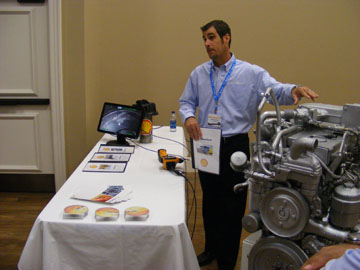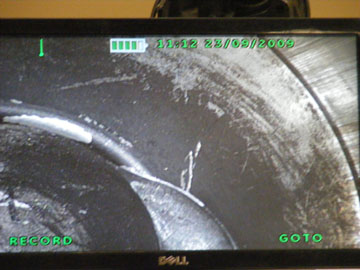Used in hundreds of engines in hundreds of fleets around the world, here are some examples of how Shell LubeVideoCheck has helped save time and money for fleet operators.
1. Drain Interval Optimization
A Shell LubeVideoCheck inspection was performed on a 6-cylinder diesel engine used in a fuel-transport tractor. The customer wanted to verify that his current 20,000-mile oil-drain interval was appropriate for the fleet. The check found no flaws or issue and showed that the engine parts had unusually low amounts of deposits and wear. The customer made the decision to extend the oil drain intervals even further.
2. Maintenance Confirmation
An inspection was performed on another 6-cylinder diesel used in a delivery truck. The constant stop-and-go conditions put the engine under immense strain and the owner wanted to be sure the lubricant was performing adequately and the drain interval was appropriate. The Shell LubeVideoCheck found only light wear on the thrust side of the piston liner and low wear and minimal deposits on the remainder of the cylinder.
3. Avoiding Potential On-Road Failure
A Shell LubeVideoCheck inspection was performed on cylinder #3 of a diesel engine used in an over the road transport tractor. The owner had been experiencing engine trouble but was unsure of the cause, although he didn’t think the truck needed to be taken out of service. The inspection showed that while the piston showed no notable deposits or problems as a result of oil performance, major damage along the piston crown and outside edge of the crown was observed. Further inspection of the damage to the piston in cylinder #3 was recommended and the owner, based on this recommendation and his own mechanic’s observation, did not put the truck back into service, helping avoid a potential on-road failure.
Other inspections have revealed damage before it caused problems, verified performance and helped to explain away anomalies in engines of all sizes, on the road, in the shop and in the field.
What Does A Shell LubeVideoCheck Offer
A videoscope, or miniature digital camera, is fed into the engine and transmits video image of key engine components to a high resolution monitor. The inspection can result in:
• Standard diesel-engine inspection of piston crown, combustion chamber, cylinder walls and valves/head;
• Recorded video images of key engine components;
• Customer report including key findings, observations, diagnosis and recommendations, if any; and
• Ongoing tracking of value delivered if customer also participates in Shell Fleet Management Program.
Greater benefits can be delivered when the Shell LubeVideoCheck is used in conjunction with Shell LubeAnalyst Oil Conditioning Monitoring.
Available for both diesel and gas engines where fuel injectors or spark plugs can be removed, a Shell Lubricants representative can review your requirements and schedule a time for a demonstration of the service in your location. A trained Shell LubeVideoCheck operator inspects the components in each engine and video images are recorded and interpreted. A report is custom made to your needs and prepared to your specification. The reports include a condition report, highlighting any problems, causes and actions required. These recommendations are then explained to you, allowing you to determine which course of action may be right for your case.
To arrange for a demonstration of the Shell LubeVideoCheck service, contact your local Shell Lubricants representative or call 800-231-6950. Or visit www.shell.com/us/lubricants.











